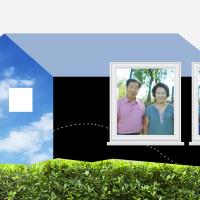Every morning, as students enter the doors at Robeson High School in Philadelphia, Principal Richard Gordon is there to greet them with a hug, a handshake or a dap. Sometimes it’s a handshake and a one-handed bro hug for the male students at the school. And when addressing the school over the PA, he refers to the students and faculty as “family.”
This humanistic, compassionate approach to education is how Robeson was able to transform itself from one of the worst-performing schools in the city to one of the best — and this approach may be the key to closing the education gap more broadly.
“We actually have to listen to the kids, give them a voice in the building, let them know we care about them, let them know how much we love them, and let them know we’re developing activities that align with their interests,” Gordon says.
Community schools close the education gap
Robeson’s education philosophy, known as community schooling, treats a school not just a place for students to take classes but as a hub for the entire community.
The hope is that by tending to the mental, physical, intellectual and emotional development of everyone in the community, a school can improve public health and create more connected, resilient, better educated humans — students and adults alike.
That holistic approach helps close the education gap between wealthy and under-resourced schools.
“We have to get kids to love school. If we get them to love school, it fosters their commitment to getting a great education. It motivates them to overcome and transcend their circumstances to be the best students they could possibly be,” Gordon says, explaining the central tenet to community schooling.
Conceptually, community schooling has been around since 1902, when seminal educational reformer John Dewey espoused the idea in a speech to the National Education Association. Though the idea has been championed by educators ever since, it’s rarely implemented in schools. Many school districts instead opt for test-based evaluations of student and school performance.
At Robeson, the community schooling process is deductive. Robeson teachers and staff will identify the specific needs of their students and residents of the surrounding community. The Robeson officials then meet with administrators from the Netter Center, the community outreach arm at the nearby University of Pennsylvania, to develop university-assisted community school programming to address those challenges.
Many of the resultant programs are activities not typically offered in inner-city public schools. Robeson provides a communal garden for its neighborhood, for instance. The school conducted a vaccination drive earlier this year, an important program considering its community has been skeptical of the Covid vaccine.
Exposure to new careers
UPenn student Hakiem Ellison says he never would have gone to the university were it not for the summer school classes he took while a student at Robeson.
“The program I was able to do in the summer enriched my learning and allowed me to say, ‘I want to go in this direction.’ I could let my curiosity grow,” Ellison says. “It was very, very unlikely I would have gone to Penn if it wasn’t for those people who intervened in my life.”
Ellison is now paying it forward by teaching his own after school program, Robeson Writes, which teaches Robeson students to express themselves through writing.
Getting students to develop their own programming is one of the core tenets of community schooling, as it encourages students to directly engage with their school and neighborhood.
It also helps broaden their perception of what’s possible.
“Once we start talking about the resources we have over at Penn, the students get excited,” Gordon says. “They ask, ‘Really? That can happen?’ Yes, it can.”
A lack of exposure is one of the biggest problems for students on the wrong side of the education gap, according to Gordon.
“A lot of time students are limited by just not knowing what’s available to them. How do you know you can be a doctor or a nurse or a physical therapist if you’ve never had the opportunity to learn what those jobs entail, how many years of education they require, what kind of subjects you’ll be studying?” he says.
That’s why Robeson and UPenn have collaborated on a slew of professional development courses aimed at preparing students for corporate life.
The Bridges to Wealth program features instructors from Penn’s Wharton School of Business, one of the most prestigious business schools in the country, teaching Robeson students about financial literacy and entrepreneurship.
“Being in a high poverty city, our kids are statistically vulnerable,” Gordon says. “We understand that they have a lot of responsibilities on their shoulders and a lot of things they have to be concerned about. Academics might be third or fourth on their list.”
Beyond academics
The benefits of these programs extend to the classroom. Not only are Robeson students more well-rounded, but their test scores have improved, as well. Before partnering with Penn, Robeson was a perpetually underperforming school at risk of closure. Now it’s one of the best performing schools in the Philadelphia public school system.
The success of the Robeson-UPenn partnership can serve as a template for addressing the education gap nationwide, according to Netter Center officials. Robeson is one of eight schools in West Philadelphia working with the Netter Center, and the center is hoping to expand its model to other universities and high schools in the U.S.
The end result of closing the education gap is more than just a better experience at school, it’s a better life.
“The purpose of an education is to help students carve out a life for themselves,” Gordon says. “One filled with happiness, fulfillment and purpose. And when our kids don’t have a quality education, they have a hard time finding those things.”


